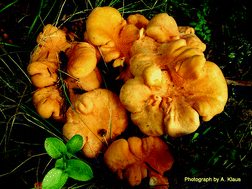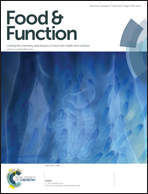Nutraceutical properties of the methanolic extract of edible mushroom Cantharellus cibarius (Fries): primary mechanisms
Abstract
The methanolic extract of the wild edible mushroom Cantharellus cibarius Fr. (chanterelle) was analyzed for in vitro antioxidative, cytotoxic, antihypertensive and antibacterial activities. Various primary and secondary metabolites were found. Phenols were the major antioxidant components found in the extract (49.8 mg g−1), followed by flavonoids, whose content was approximately 86% of the total phenol content. Antioxidant activity, measured by four different methods, was high for inhibition of lipid peroxidation (EC50 = 1.21 mg mL−1) and chelating ability (EC50 = 0.64 mg mL−1). The antioxidant activity of the C. cibarius methanol extract was achieved through chelating iron compared to hydrogen atom and/or electron transfer. The extract showed good selectivity in cytotoxicity on human cervix adenocarcinoma HeLa, breast carcinoma MDA-MB-453 and human myelogenous leukemia K562, compared to normal control human fetal lung fibroblasts MRC-5 and human lung bronchial epithelial cells BEAS-2B. The extract had inhibitory activity against angiotensin converting I enzyme (ACE) (IC50 = 0.063 mg mL−1). The extract revealed selective antimicrobial activity against Gram-positive bacteria with the highest potential against E. faecalis. The medicinal and health benefits, observed in wild C. cibarius mushroom, seem an additional reason for its traditional use as a popular delicacy food.


 Please wait while we load your content...
Please wait while we load your content...